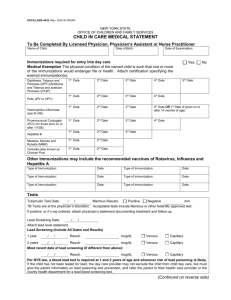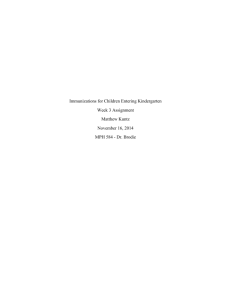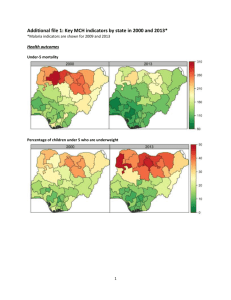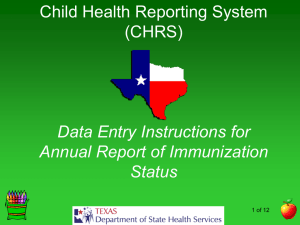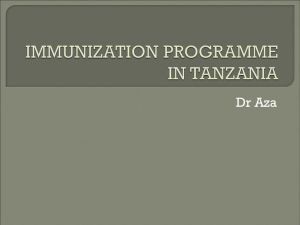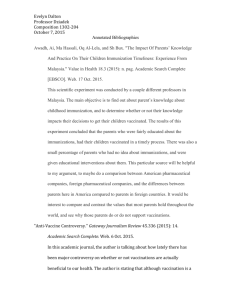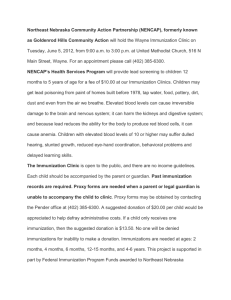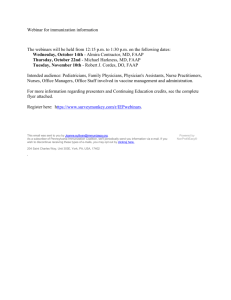Kindergarten Immunizations
advertisement
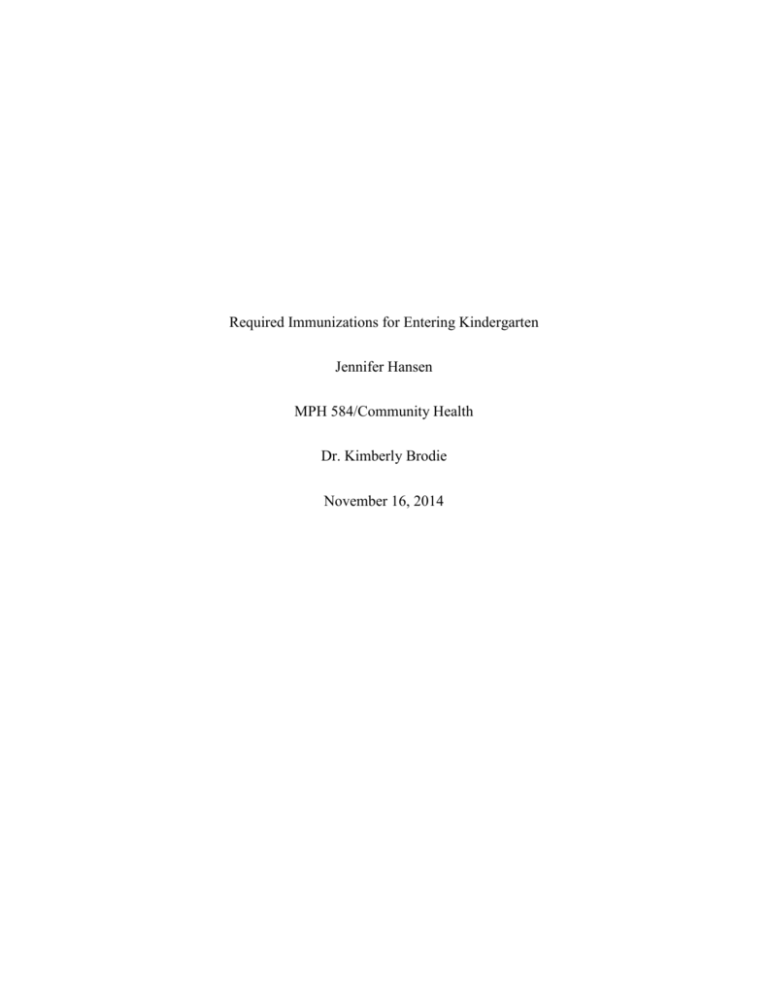
Required Immunizations for Entering Kindergarten Jennifer Hansen MPH 584/Community Health Dr. Kimberly Brodie November 16, 2014 According to the Centers for Disease Control and Prevention’s Morbidity and Mortality Weekly Report, ([CDC]; 2013), in the United States, it is the responsibility and right of each state and their schools to determine which immunizations students are required to get to enter Kindergarten. These requirements serve to ensure high vaccination coverage, increase herd immunity, and decrease the risk of allowing vaccine-preventable illnesses to penetrate schools and deteriorate the health of faculty and students (CDC, 2013). Since it is up to the states to set immunization standards for children entering kindergarten, there is some slight geographical variation in required vaccines. However, after analyzing school immunization requirements among the States and Washington, D.C., it appears vaccinations for measles, mumps, and rubella (MMR), diphtheria, tetanus toxoid, and acellular pertussis (DTaP), and polio are required by all students entering Kindergarten (CDC, 2011). In addition, varicella (chickenpox) and Hepatitis B vaccinations are required in most states, and Hepatitis A, meningococcal, and pneumococcal vaccines are only required in some states. The influenza vaccine is required to enter Kindergarten in the state of Connecticut (ProCon.org, 2014). Medical exemptions for required immunization are present in all 50 states, and religious and philosophical exemptions exist in some states. While not all states require full immunization for all preventable diseases, the CDC publishes a recommended immunization schedule to ensure children are fully immunized prior to entering Kindergarten. Although there are many arguments on both sides of the fence regarding the safety and efficacy of vaccinations and the immunization schedule recommended for children entering Kindergarten, the medical community as a whole is in favor of vaccinations and following the routine recommended immunization schedule from infancy through adulthood. The CDC, the United States Department of Health and Human Services (DHHS), the National Institutes of Health (NIH), the Institute of Medicine (IOM), and the American Association of Pediatrics (AAP) all express their full support of childhood vaccinations, believe vaccine benefits far outweigh any associated risks, and promote immunizations as the safest and most cost-effective means to prevent disease, disability, and death (Wood, n.d.). In order to address any misinformation circulated by anti-vaccine advocates, the IOM has recently published a report in which they review the childhood immunization schedule printed by the U.S. Advisory Committee on Immunization Practices and the associated benefits and risks of following the schedule (IOM, 2013). In their report, the IOM provides an in-depth review of popular stakeholder concerns regarding immunizations and their responses upon investigating the scientific evidence surrounding the safety and efficacy of adhering to the childhood immunization schedule (IOM, 2013). The IOM’s report, The Childhood Immunization Schedule and Safety, was published in January, 2013 and analyzed studies from the past 10 years that looked for any associations between routine vaccines and negative health outcomes (IOM, 2013). IOM researchers found no evidence supportive of any links between the childhood immunization schedule and autoimmune diseases, asthma, hypersensitivity, seizures, child developmental disorders, learning or developmental disorders, or attention deficit or disruptive disorders (IOM, 2013). The study also found that while there were no evidence of major safety concerns associated with following the childhood immunization schedule, children with current immunizations had a significantly reduced risk of developing vaccine-preventable diseases (IOM, 2013). In addition, according to the World Health Organization (WHO) and the United Nations Children’s Fund’s (UNICEF) 2997 Immunization Summary (2008), vaccination against just four diseases—diphtheria, tetanus, pertussis (DTP), and measles—prevent over 2.5 million deaths every year. In order for these vaccines to continue protecting schoolchildren, especially those with compromised immune systems from preventable diseases, it is important to maintain herd immunity through achieving high rates of students who are fully immunized (Ciolli, 2008). Based on the evidence, in my opinion, the development and widespread administration of vaccines is the most important public health achievement of the 20th century and beyond. All one must do in order to determine the effectiveness of immunizations and herd immunity is to compare early mortality rates from infectious diseases 100 years ago to the same today. Although I understand there are some rare side effects and potential complications from vaccines, I believe their safety and efficacy continues to be improved as technology advances, and the benefits of immunizations far outweigh the risks. Until I am presented with as much factual and experience-based evidence showing the risks of vaccines to be greater than the benefits received, I will continue to support their widespread use and administration. References CDC. MMWR. (2013). Vaccination coverage among children in kindergarten – United States, 2012-13 school year [abstract]. Retrieved November 13, 2014 from http://www.ncbi.nlm.nih.gov/pubmed/23903595. CDC. (2011). School vaccination requirements, exemptions and web links. Retrieved November 13, 2014 from http://www2a.cdc.gov/nip/schoolsurv/schImmRqmt.asp. Ciolli, A. (2008, September). Mandatory school vaccinations: The role of Tort Law. Yale Journal of Biology and Medicine, 81(3), p 129-137. IOM. (2013). The childhood immunization schedule and safety: Stakeholder concerns, scientific evidence, and future studies. Retrieved November 14, 2014 from http://www.iom.edu/Reports/2013/The-Childhood-Immunization-Schedule-andSafety.aspx. ProCon.org. (2014). Vaccines pros and cons. State-by-state: Vaccinations required for public school kindergarten. Retrieved November 13, 2014 from http://vaccines.procon.org/view.resource.php?resourceID=005979. WHO. (2008). No vaccine for the scaremongers. Bulletin of the World Health Organization, 86(6), p 417-496. Retrieved November 15, 2014 from http://www.who.int/bulletin/volumes/86/6/08-030608/en/. Wood, D. (n.d.). Immunization in the medical home [Powerpoint slides]. American Academy of Pediatrics (AAP). Retrieved November 14, 2014 from https://www2.aap.org/immunization/.
